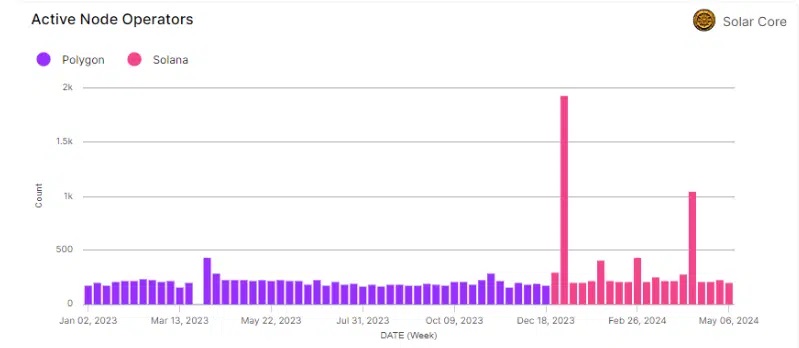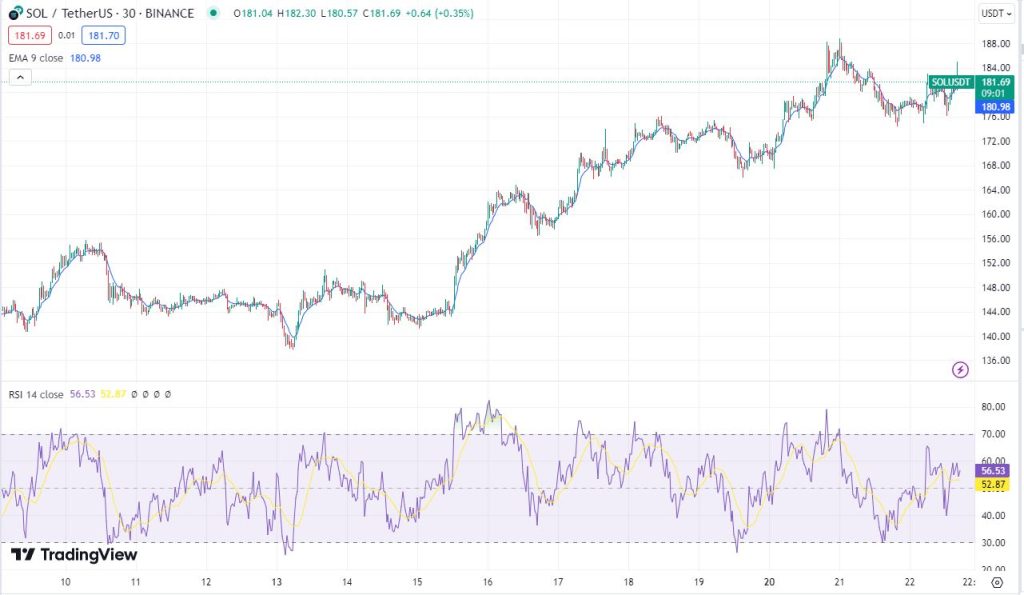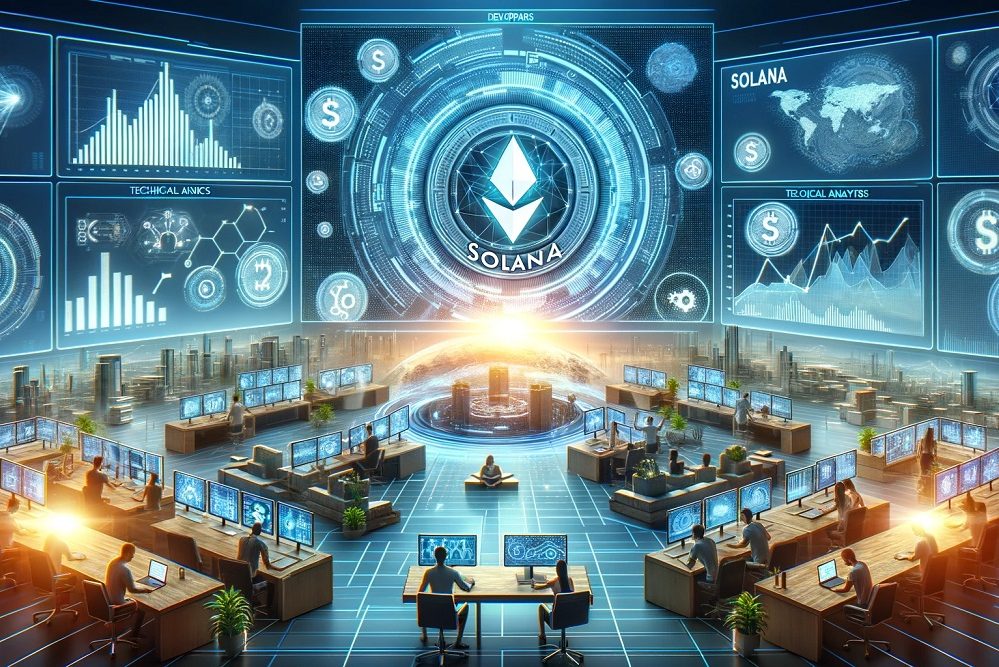The Decentralized Physical Infrastructure Network (DePIN) is utilizing decentralized, community-driven networks to boost infrastructural efficiency and resilience, particularly in sectors such as AI and data storage. DePIN is fostering a broad range of applications by incentivizing decentralized services, extending its benefits within and outside the Web3 environment.
The Flipside report highlights Solana as a preferred platform for DePIN initiatives due to its capabilities for high-speed transactions, low costs, and solid infrastructure. Garrison Yang, the chief strategy & marketing officer at io.net, noted in the report that DePIN projects heavily depend on community engagement due to their nature as decentralized hardware networks. He emphasized that many projects, including io.net, are opting for Solana, recognizing it as the fastest-growing ecosystem in the cryptocurrency landscape.
Render Network Expands Operations and Influence Post-Solana Migration
Render Network has emerged as a leader in decentralized GPU rendering, providing scalable and cost-efficient computing power essential for AI, media rendering, and scientific research. After transitioning to the Solana blockchain in November 2023, the network has successfully rendered approximately 33 million frames, translating to about 33,000 GPU hours, utilizing NVIDIA RTX 3090 GPUs.
The number of active node operators on Render Network reached a peak of 1,900 in January 2024, which represents a 66.3% increase following the migration to Solana. This surge in participation is largely due to the growing recognition of Render’s capabilities and the supportive environment offered by Solana. Following the migration, rewards for node operators also increased by 34.3%, reaching a high of 228,000 RNDR in early January 2024.
Moreover, Render has implemented a new Burn and Mint Equilibrium (BME) mechanism that has stabilized the dynamics of RNDR supply and demand. Despite these positive developments, Render faces increasing competition in the decentralized computing arena, which could influence its market position.

Helium Enhances Mobile Network with New Features and International Expansion
Helium Network, recognized as the world’s largest decentralized network, has seen significant expansion, particularly within its mobile network segment. This growth is highlighted by the predominance of token burns in Helium’s mobile network, which now greatly exceed those in its IoT network. This trend is fueled by the rapid uptake of Helium Mobile services.
As of January 2024, the number of Helium Mobile subscribers reached a peak of nearly 90,000, driven by competitive pricing structures and incentives involving the MOBILE token. The Helium Mobile Discovery Rewards program has seen a marked acceleration since December 2023, surpassing the growth rate of new subscribers. This surge is attributed to improved reward mechanisms and intensified efforts to combat fraudulent activities, ensuring that genuine contributors are amply rewarded.
Helium has also introduced new features such as Group Plans, Hex Boosting, and an international roaming option, which have significantly enhanced the attractiveness of Helium Mobile. Furthermore, a strategic partnership with Telefonica to extend coverage into Mexico underscores Helium’s expanding influence in the sector.
Despite Helium’s prominence in decentralized connectivity, other smaller projects are also making significant inroads. WiFi Dabba is providing affordable, high-speed internet access in India via a network of micro-ISPs, utilizing blockchain technology for its payment systems. Pollen Mobile offers users the ability to establish and manage their own secure, private cell networks. In addition, Uprock is developing a gamified peer-to-peer network where participants can store, access, and share data, earning rewards for various contributions to the ecosystem.
Solana (SOL Technical Analysis And Forecast
The chart below offers a detailed look into Solana’s performance against US Tether (SOLUSDT), with the 30-minute frame showcasing its fluctuating journey marked by the Exponential Moving Average (EMA) and the Relative Strength Index (RSI).
Currently, the 9-day EMA is positioned at roughly $180.98, marking a critical point for traders. This level reflects an ongoing struggle between buyers and sellers, with Solana’s price wavering around this average. The EMA is particularly significant as it aids in identifying short-term trends; presently, Solana’s slight position above the EMA suggests a minor bullish outlook in the near term.

Meanwhile, the RSI, displayed in light purple on the graph, registers at 56.53. Positioned above the neutral 50 mark yet below the overbought line of 70, the RSI indicates that Solana maintains positive momentum, albeit not to the degree of being overbought. This status implies that there is still potential for upward price movement without the immediate risk of significant corrections often associated with overvalued conditions.
Analyzing Support and Resistance Levels
The price of Solana has consistently found a robust support zone at $176, where it has stabilized and rebounded following declines. Analysis of trading patterns shows that each time Solana’s price neared this level, it attracted sufficient buying interest to halt further drops. This buyer engagement suggests that traders and investors recognize value at this price point, thereby pushing the price upward again.
Should Solana’s price dip below this initial support, it is expected to encounter another significant support at $172.00. Historical trading data reveal that this price level has frequently served dual roles as support and resistance, highlighting its importance to market participants.
Conversely, Solana has encountered minor resistance between $181.70 and $182.00, a range where upward momentum has repeatedly stalled. The price typically reaches this range, then pulls back, reflecting selling pressure that limits further gains.
If Solana were to ascend beyond this initial resistance zone, it would face a subsequent hurdle at approximately $184.00. At this higher price level, selling activity could intensify as traders and investors might look to capitalize on profits, recognizing this as a challenging threshold historically resistant to breakthroughs.
Finally, if Solana sustains its position above the EMA and the RSI continues to climb towards but not exceed 70, it could see further price appreciation. Conversely, a drop below the EMA with an accompanying RSI dip below 50 could signal a bearish turn, pointing towards increased selling pressure.
- Crypto Price Update July 24: BTC Maintains $66K, ETH at $3.4K, XRP, TON, and ADA Rallies
- Bitcoin Falls to $65K as Mt. Gox Transfers $2.8 Billion BTC to External Wallet
- News of Marathon Digital’s $138 Million Fine for Breach of Non-Disclosure Agreement Triggers a Bearish 2.5% of Its MARA Stock
- Are $530M Bitcoin ETF Inflows a Blessing or Caution?
- Metaplanet Teams with Hoseki for Real-Time Bitcoin Holdings Verification
- Building Secure Blockchain Systems: An Exclusive Interview with ARPA and Bella Protocol CEO Felix Xu
- Building The “De-Facto Crypto Trading Terminal”: An Exclusive Interview with Aurox CEO Giorgi Khazaradze
- Building a New Global Financial System: An Exclusive Interview With Tyler Wallace, Analytics Head at TrustToken
- “Solana is the Promised Land for Blockchain” — An Exclusive Interview with Solend Founder Rooter
- El Salvador: Where The Bitcoin Revolution Begins With A Legal Tender

 Why Trust Us
Why Trust Us







